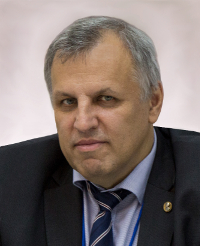Valerii Ivanovich Bukhtiyarov is Academician of Russian Academy of Sciences (2016), Doctor of Chemistry (1999), Professor (2003). He specializes in the field of physicochemistry of surface, heterogeneous catalysis and functional nanomaterials, and published more than 300 research papers and registered 16 patents for inventions.
He was born on October 14, 1961, in Novosibirsk, and in 1983 graduated magna cum laude from Novosibirsk State University with a degree in chemistry.

The whole work life of Valerii Bukhtiyarov is dedicated to Institute of Catalysis, where he began his career as research assistant in 1983.
In two years he became a postgraduate student, in two more years, junior research worker. Then he defended his thesis for the degree of Candidate of Chemistry (PhD), worked as research associate and then senior research associate. In 1995-2000 V.I. Bukhtiyarov was the academic secretary of the Institute.
In 1999 he defended his thesis for the degree of Doctor of Chemistry, titled “From Single Crystals to Nanoparticles: A Molecular Approach to the Study of the Reasons for Catalytic Activity of Silver in Reaction of Ethylene Epoxidation”.
He had been the head of the Department of Heterogeneous Catalysis for 21 years beginning from 2000.
In 2002-2015 V.I. Bukhtiyarov held the position of director deputy of the Institute.
In 2008 he was elected to be Corresponding Member of RAS, in 2013 occupied the position of the Academic Secretary General of Siberian Branch of RAS.
Since 2015 Valerii I. Bukhtiyarov is Director of Boreskov Institute of Catalysis. In October 2016 he was elected Academician of RAS.
Awards
In 2003 V.I. Bukhtiyarov won the award of Lavrentiev Foundation for the Young Scientists for prominent contribution into the development of Siberia and the Far East.
In 2016 he was awarded the Balandin Award for the series of works “Nanostructuring of the Active Component as a Method of Managing the Catalytic Properties of the Supported Metal Catalysts in the Reactions of Hydrogenation and Oxidation” (as a member of the research team). The award is established by Russian Academy of Sciences and is given for the prominent works in the field of catalysis.
In 2020 he was elected a member of Academia Europaea.
Research Activity
The scope of the scientific interests of V.I. Bukhtiyarov includes the study of the elementary chemical processes on the surface of solid bodies involving the up-to-date physical in situ methods, the determining of the interrelation “structure – activity” in heterogeneous catalysts, the development of the methods of the controlled synthesis of functional nanomaterials for the catalytic uses. The purpose of the studies is to determine the structure of the active sites of the catalysts, their transformation in the course of the catalytic reactions, and establishing of the interrelation between the structure and composition of the surface of heterogeneous catalyst and its catalytic properties in the industrially significant reactions.
To study the structure of the catalysts (supported metals, massive and supported oxides of metals, zeolites), in particular, the local composition and structure of the catalytically active sites, V.I. Bukhtiyarov suggested using the complex of various spectroscopy methods, including X-ray diffraction (XRD), X-ray photoelectron spectroscopy (XPS), extended X-ray absorption fine structure (EXAFS), X-ray absorption near-edge structure (XANES), nuclear magnetic resonance (NMR), IR visible region, etc. In many cases, the suggested structures of the active sites are confirmed by the quantum-chemical calculations.
To reveal the sequence of the stages of the elementary reactions, when the reagents turn into the products, V.I. Bukhtiyarov uses the spectroscopy in situ methods. His latest activity in the controlled synthesis of nanocomposite materials allows completion of the fundamental approach to the development of the new catalytic systems, the approach being that the molecular design of heterogeneous catalysts with the improved catalytic properties (activity, selectivity, stability) is based on the detail study of the mechanism of the studied reaction and structure of the active sites at the atomic level.
The examples of the catalytic processes for which this approach was successfully used include the reactions of epoxidation of ethylene on silver, partial oxidation of methanol into formaldehyde on copper and mixed V-Ti-O oxides, low-temperature synthesis of ammonia on ruthenium promoted with alkali metals, complete oxidation of hydrocarbons and CO on noble metals (platinum, palladium, gold), selective oxidation of carbohydrates and electrochemical oxidation of hydrogen on gold and palladium.
Other Activities
Valerii I. Bukhtiyarov pays great attention to the international collaboration. He was a member of the Expert Council of Berlin Electron Storage Ring Society for Synchrotron Radiation (BESSY) and member at large of EFCATS Council (European Federation of Catalytic Societies). Today he is the representative of Russia in WCOC International Board (World Congress on Oxidation Catalysis). He also coordinates the Russian part of the project “Development of the in situ methods of the solid surfaces” carried out with Fritz-Haber Institute (Max Planck Society, Berlin).
V.I. Bukhtiyarov takes an active part in the training of the researchers. Since 2000 he heads the chair of catalysis and adsorption of the Natural Sciences Department in Novosibirsk State University. Eleven theses for the degree of Candidate of Chemistry were successfully defended under his supervising.
V.I. Bukhtiyarov is the vice-chairman of the Joint Scientific Council in Chemistry of SB RAS, member of the thesis boards D 003.012.01 (Boreskov Institute of Catalysis SB RAS) and D 003.051.01 (Institute of Inorganic Chemistry SB RAS). He is also an editor-in-chief of “Kinetics and Catalysis” journal and a member of the editorial boards of “Journal of Structural Chemistry”.